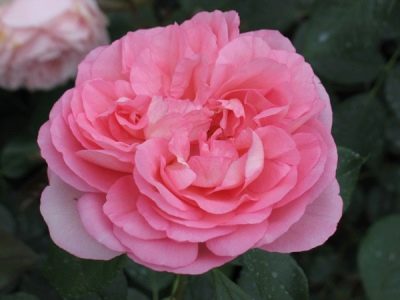
- Authors: Christian Evers
- Name synonyms: Voyage
- Breeding year: 2013
- Group: tea-hybrid
- The main color of the flower: pink
- Flower shape: spherical to square
- Flower size: large
- Diameter, cm: 8-12
- Flower type by number of petals: medium terry
- Scent: roses
In 2013, breeder Christian Evers introduced a new variety of hybrid tea roses and gave it the original name - Voyage. In just a few years, roses of this variety have become incredibly popular among flower growers. They have many benefits and positive characteristics. But in order to grow really beautiful and healthy pink flowers, you need to properly care for them.
Description of the variety
Voyage belongs to the category of hybrid tea roses. They are intended for cutting, suitable for growing on a personal plot as a standard crop. Will be a worthy decoration for any flower bed.
The bushes are quite compact: they rarely exceed 100 cm in height, and grow no more than 60 cm in width. On the stems there are medium-sized leaves, saturated dark green with a relatively glossy surface.
Due to its high frost resistance, this variety is suitable for growing in the regions of central Russia, as well as in the northern regions.
Advantages and disadvantages
The variety has many advantages. Among the most significant of them, it is worth highlighting:
- resistance to temperature extremes;
- compact size of the bush;
- large inflorescences;
- intense flowering.
Among the disadvantages, it should be noted that roses of this variety are susceptible to increased moisture content in the soil. In this condition, they begin to bloom badly and hurt.
Flowering features
The flowering period of roses of this variety is quite long, since it begins in July and ends only in early autumn. The rose is re-flowering.
The buds are dark pink. After blooming, they acquire a more delicate shade. The bud is round, spherical or square in shape. The flowers are quite large in size, with a diameter ranging from 8 to 12 cm. Each flower has 26 to 40 petals.
One stem contains from 1 to 3 inflorescences. The scent is pleasant enough, but weak when compared with other roses from the same group.
Landing
It is necessary to plant roses in the fall, in the period before the onset of cold weather. To do this, you should choose and properly prepare the site. It should be well lit, with loose and fertile soil. It is imperative to equip the drainage layer.
For planting, you need to dig holes at a distance of several centimeters from each other. Accuracy should not exceed 3-5 pieces per square meter.
Then the soil should be well moistened, the seedlings should be placed in the hole, keeping the original state of the root system. Sprinkle with soil, tamp lightly and water well. After that, you need to make a shelter from arcs and plastic wrap for the first time.
Growing and care
In the spring, the planted bushes must be timely and properly cared for. It includes the following activities.
- Watering. It should be moderately abundant and timely. Roses do not tolerate both prolonged drought and abundant moisture. In the first case, the leaves will be flabby, growth will slow down, and the formed buds will begin to fall off. With excessive soil moisture, the condition of the roses will also be unsatisfactory.
- To improve the general condition, complex mineral fertilizers should be applied. They are needed not only for growth, but also for abundant and timely flowering.During the budding period, the plant urgently needs potassium-containing preparations. These include saltpeter, potassium chloride, salt, or potassium sulfate.
- For preventive and sanitary purposes, it is recommended to do timely pruning of the bushes. Dried or diseased shoots should be removed.
Due to a violation of the conditions of agricultural technology, roses begin to hurt. The most common ailments are powdery mildew and gray mold. This variety is quite resistant to such phenomena, but the appearance of symptoms is not excluded.
If the plant is attacked by powdery mildew, then the first symptom will be the appearance on the stems, leaves and petals of a specific coating of white-gray color. At first, the disease will simply spoil the appearance, and then intensify the attack. As a result, the plant may die altogether.
Appropriate treatment will help correct the situation. To get rid of powdery mildew, it is recommended to treat the culture with a solution of fungicides. The most common of these are Fundazol and Topaz. Also, Fitosporin-M has no less effect. This is a proven and inexpensive remedy that will help cope with the disease, even if it is in an advanced stage.
Gray rot most often affects those flowers that grow in excessively moist soil. The first symptom is the appearance of dark gray spots on the leaves. Further, as the disease develops, complete wilting begins. In order to prevent such a condition, it is recommended to start treatment in a timely manner.
It is necessary to stop watering for a while and intensify soil loosening. Under these conditions, the fungus will not be able to develop, so it will soon die. With the help of complex fertilizers, the immunity of the crop can be restored.
If you follow the rules of agricultural technology, then you can successfully grow roses of this variety on your personal plot. They are not afraid of cold weather, they are distinguished by abundant and long flowering, therefore they will become an ideal decoration for the territory.































































